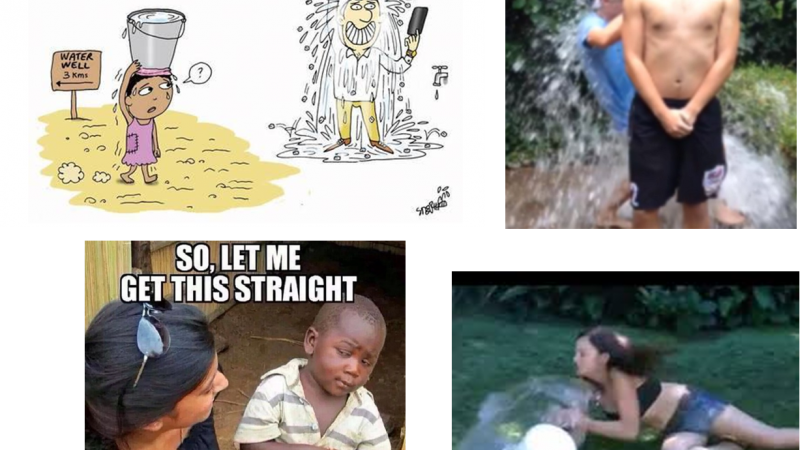
Photomontage of reactions to the Ice Bucket Challenge
The Ice Bucket Challenge as a viral meme is now a few months old and the results are in: quite a few people have taken the challenge (at least 1.2 million participants to be exact), and people around the world have tried to emulate its popularity for other causes.
The campaign, which began in early summer, took off with a US audience television anchor Matt Lauer performed the challenge live on his NBC television show on July 15. Soon after, well-known figures from ex-President George W. Bush to movie star Benedict Cumberbath also participated in the challenge, anchoring the viral phenomenon and its subsequent inevitable backlash.
While the campaign raised an estimated $41.8 million in donations from July 29 until August 21 from more than 739,000 new donors, critics have argued that the campaign was more focused on fun and self-congratulating deeds rather than donating money to charity.
A conversation between Global Voices contributors about reactions to the Ice Bucket Challenge revealed conflicted feelings about the meme. Global Voices’ South Asia Editor Rezwan from Bangladesh opined:
the topic has become a cliche and many are kind of annoyed when people share these stuffs.
Anna Schetnikova, a Global Voices Russian contributor, asserted that skepticism about the campaign's impact is very strong in the Russian-speaking web:
many people send these video just for fun, and they don't really know what this campaign means.
In Kenya, Twitter user Njambi Magugu posted a cartoon highlighting the contrast in priorities in different regions of the world:
“@Belalmd12: Thousands die from ALS, but dehydration kills millions every year. Prioritize! pic.twitter.com/xDOirT5O7w” @NjeriThorne
— Njambi Magugu (@Mimmylovesart) August 31, 2014
Others showed support for the campaign, like Global Voices contributor Anushe Noor Faheem from Pakistan:
I hope that people try to learn about the disease. Here in Pakistan [..] many celebrities have taken the challenge.
There is no denying that more people are now more aware of ALS than ever before. This is a positive outcome that was best explained by Anthony Carbajal in California who posted a poignant video showing his participation in the Ice Bucket Challenge. Carbajal learned in January 2014 that he has ALS. His family has a history of cases with ALS: his grandmother died from it, and his mother currently has it. Carbajal had been caring for his mother when he learned that he too was sick. Then the viral campaign took off.
In the following video, he explains what the challenge means to him and other who suffers from ALS:
Here is an excerpt from Carbajal's plea on video:
I hate talking about it, I really hate talking about it. That’s probably why no one talks about it, because it’s so challenging to watch. Nobody wants to see a depressing person who is dying, who has two to five years to live. […] I promise your news feed will go back to cat videos and ‘Let It Go‘ covers, but right now the ALS community has the main spotlight […] You have no idea how every single challenge makes me feel – lifts my spirits, lifts every single ALS patient’s spirits. You are really, truly making a difference and we are so, so, so grateful.
The challenge had made people more aware of ALS and the struggle it presents as seen in Carbajal's story. From that standpoint alone, it is difficult to question the motives of people willing to participate in the challenge, however self-promoting it may appear.
There is also no denying that other diseases are overall deadlier than ALS. For activists who would like to emulate the popularity of the challenge for their own cause, there are certain lessons that can be learned from the viral phenomenon.
1) Don't get hurt
Here is a compilation of Ice Bucket Challenge gone wrong:
It should go without saying, but if you are going to do the challenge, please take the necessary precautions beforehand or you might get hurt.
2) Don't just imitate
Beth Kanter, a social media expert for non-profits, explains that given the success of the campaign, other charity organisations are tempted to ride the wave by doing what she calls “charity jacking“:
Scores of nonprofit fundraising staffers report being called on to replicate the challenge. […] Charity Jacking is similar to brand jacking and news jacking, defined by David Meerman Scott as the process by which you inject your ideas or angles into breaking news, in real-time, in order to generate media coverage for yourself or your organization.It creates a level playing field—literally anyone can newsjack—but, that new level favors players who are observant, quick to react, and skilled at communicating.
However, Kanter warns in a follow-up post that just imitating the challenge might not work:
Some aspects of the Ice Bucket Challenge can’t be replicated. Most likely, no matter how your nonprofit incorporates some of the best practices, you probably won’t raise $100 million and get hundreds of celebrities to participate on their own. But you can certainly incorporate some of the best practices like social proofing, fun call to action, and embracing free agents to get better results.
3) Simple works
The challenge was focused around a worthy issue, but the concept was also easy to understand. Furthermore, seeing people do something out of their comfort zone spurred others to also engage. Now if one can get the same level of engagement for other causes, the Ice Bucket Challenge can truly become a win-win situation for all activists worldwide.
Thalia Rahme, Rezwan, Anna Schetnikova, Leila Nachawati, Anushe Noor Faheem, Sanjib Chadhury, Laura Vidal have contributed to this article.







2 comments
I think with a campaign like this the ends justify the means – as I’ve tried to argue here:
http://lovelanguageloveliterature.com/2014/09/05/are-you-morally-bankrupt/